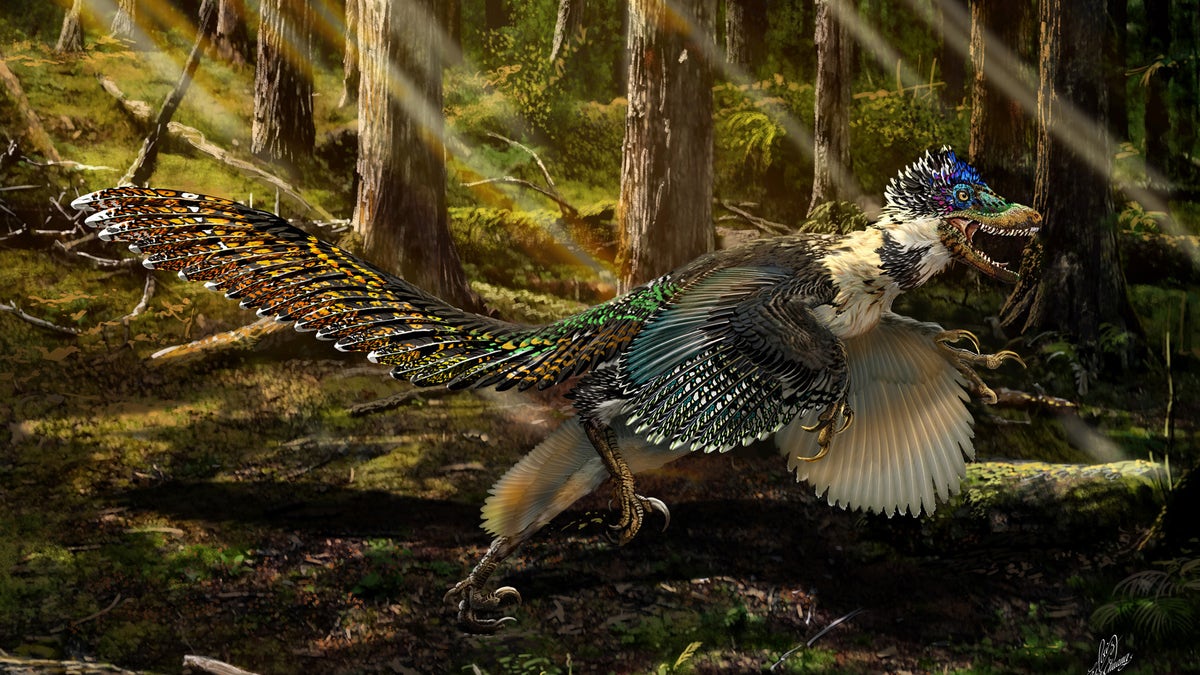
(University of Edinburgh)
If the original “Jurassic Park” film was made today, its velociraptors may have had feathers. A study from the the University of Edinburgh reveals that fossils of a new dinosaur dubbed Zhenyuanlong suni — a close cousin of the iconic raptor — were recently discovered in China. Unlike its movie star relative, this dinosaur had feathers and wings.
“This is the largest feathered dinosaur [discovered] with a complex set of wings, made up of layers of quill-pen-type feathers, “ study co-author and University of Edinburgh paleontologist Steve Brussatte told Foxnews.com. “It was about six and a half feet long and weighed 44 pounds, or so. Not a giant compared to T. rex or Brachiosaurus, but very big for a dinosaur with huge wings.”
The fossils were discovered in Liaoning Province in northeastern China, where thousands of other feathered dinosaurs have been unearthed. The skeleton was found complete and remarkably well–preserved, which Brussatte attributed to volcanic activity in the area.
“Volcanoes would occasionally erupt and bury these animals, turning them to stone, like a prehistoric Pompeii,” he said. “They were buried so quickly, in the right chemical environment, that soft tissues like feathers didn't have time to decay, so they were often preserved.”
Unlike the other feathered dinosaurs in the area, Zhenyuanlong is a totally new species, something researchers have never seen in 20 years of work in the area.
The new dinosaur is a part of the family Dromaeosuaridae, which consisted of small-to-medium-sized, feathered meat eaters that thrived in the Cretaceous Period 125 million years ago. While larger feathered dinosaurs have been found previously, none had ever possessed Zhenyuanlong’s complex, multi-layered bird–like wings.
“We do have larger feathered dinosaurs, like the close T. rex cousin Yutyrannus, which is 26 to 29 feet long,” Brussatte explained. “But these are more primitive dinosaurs, and they have more primitive feathers. They merely have simple hair-like feathers, which don't look much like most modern bird feathers. Only later in dinosaur evolution did the feathers become larger and more complex, take the shape of a quill pen (with a central shaft and many branches from the shaft), and then gather into wings.”
Despite the large wings, which have a span the size of an average human’s arm, it’s a mystery as to whether or not the raptor cousin could fly. Brussatte said he doubts they could, based on the dinosaurs extremely short arm bones, which measure about a mere 0.4-inches length.
“Although there are some minor differences, in general, the wings are basically indistinguishable from those of hawks or vultures or other living birds,” he added. “But, there is one main difference — the bony part of the wing. The feathers are huge, but the arms are short. If you just looked at the skeleton, you would say that there is no way something with such short arms could fly.”
While arms are extremely short, the wings themselves are very large in comparison, which might have made short flights a possibility.
“Maybe Zhenyuanlong had some basic aerial abilities. Maybe it could glide or fly for very short distances, although there is no way it could fly with the same type of sustained, muscle-driven, powered flight of today's birds,” Brussatte said. “Or maybe it used its wings for display, or to brood its eggs. There are many possibilities and not one good answer.”
Feathered dinosaurs are still a recent discovery, having first been found in Liaoning Province a mere 20 years ago. Though it’s now known that Zhenyuanlong’s infamous cousin – the raptor – had feathers, evidence of feathered dinosaurs had yet to be discovered at the time of “Jurassic Park’s” release in 1993.
“About 10 years ago, a team reported the discovery of quill knobs on a Velociraptor specimen: a row of small bumps on the ulna bone of the arm, which we see in living birds,” Brussatte explained. “In birds they anchor large, complex, veined flight feathers. So this was good evidence that Velociraptor itself had feathers, and fairly complex ones, even if the feathers themselves weren't preserved.”
According to Brussate, the way these dinosaurs should have looked — at least in the new “Jurassic World” film — is actually very close to Zhenyuanlong.
“Look at Zhenyunalong and you're probably seeing, more or less, what a real Velociraptor would have looked like. Velociraptor would have been a feisty little feathered poodle from hell, not a drab, scaly reptilian monster like in the Jurassic Park films.”
The report can be found in the journal Scientific Reports and is co-authored by study leader Professor Junchang Lu of the Institute of Geology at the Chinese Academy of Geological Sciences.
